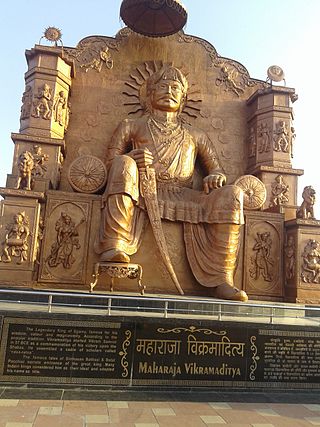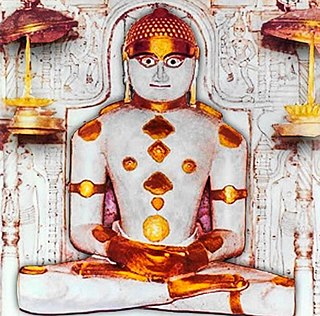This article possibly contains original research .(June 2023) |
This article needs additional citations for verification .(June 2023) |
This is a list of monarchs, royalties, and dynasties following Jainism.
This article possibly contains original research .(June 2023) |
This article needs additional citations for verification .(June 2023) |
This is a list of monarchs, royalties, and dynasties following Jainism.
This list contains rulers that are mentioned in Jain texts. They are listed as follows:

Chandragupta Maurya was the founder of the Maurya Empire, a geographically-extensive empire based in Magadha. He reigned from 320 BCE to 298 BCE. The Magadha kingdom expanded to become an empire that reached its peak under the reign of his grandson, Ashoka the Great, from 268 BCE to 231 BCE. The nature of the political formation that existed in Chandragupta's time is not certain. The Mauryan empire was a loose-knit one with large autonomous regions within its limits.

Magadha also called the Kingdom of Magadha or the Magadha Empire, was a kingdom and empire, and one of the sixteen Mahajanapadas, 'Great Kingdoms' of the Second Urbanization, based in southern Bihar in the eastern Ganges Plain, in Ancient India. Magadha was ruled by the Brihadratha dynasty, the Haryanka dynasty, the Shaishunaga dynasty, the Nanda dynasty, the Mauryan dynasty, the Shunga dynasty and the Kanva dynasty. It lost much of it territories after being defeated by the Satavahanas of Deccan in 28 BC and was reduced to a small principality around Pataliputra. Under the Mauryas, Magadha became a pan-Indian empire, covering large swaths of the Indian subcontinent and Afghanistan.

The Maurya Empire was a geographically extensive Iron Age historical power in South Asia based in Magadha. Founded by Chandragupta Maurya in 322 BCE, it existed in loose-knit fashion until 185 BCE. The empire was centralized by the conquest of the Indo-Gangetic Plain; its capital city was located at Pataliputra. Outside this imperial centre, the empire's geographical extent was dependent on the loyalty of military commanders who controlled the armed cities scattered within it. During Ashoka's rule, the empire briefly controlled the major urban hubs and arteries of the Indian subcontinent excepting the deep south. It declined for about 50 years after Ashoka's rule, and dissolved in 185 BCE with the assassination of Brihadratha by Pushyamitra Shunga and foundation of the Shunga dynasty in Magadha.

The Shishunaga dynasty was the fourth ruling dynasty of Magadha, an empire in ancient India. According to the Hindu Puranas, this dynasty was the second ruling dynasty of Magadha, succeeding Nagadashaka of the Haryanka dynasty.
Kalinga is a historical region of India. It is generally defined as the eastern coastal region between the Ganges and the Godavari rivers, although its boundaries have fluctuated with the territory of its rulers. The core territory of Kalinga now encompasses all of Odisha and some part of northern Andhra Pradesh. At its widest extent, the Kalinga region also included parts of present-day Chhattisgarh, extending up to Amarkantak in the west. In the ancient period it extended until the bank of the Ganges river.

Kosala, sometimes referred to as Uttara Kosala was one of the Mahajanapadas of ancient India. It emerged as a small state during the Late Vedic period and became one of the earliest states to transition from a lineage-based society to a monarchy. By the 6th century BCE, it had consolidated into one of the four great powers of ancient northern India, along with Magadha, Vatsa, and Avanti.

A chakravarti is an ideal universal ruler, in the history, religion, and mythologies of India. The concept is present in Indian subcontinent cultural traditions, narrative myths and lore. There are three types of chakravarti: chakravala chakravarti, an emperor who rules over all four of the continents ; dvipa chakravarti, a ruler who governs only one of those continents; and pradesha chakravarti, a monarch who leads the people of only a part of a continent, the equivalent of a local king. Dvipa chakravarti is particularly one who rules the entire Indian subcontinent. The first references to a Chakravala Chakravartin appear in monuments from the time of the early Maurya Empire, in the 4th to 3rd century BCE, in reference to Chandragupta Maurya and his grandson Ashoka.

Vatsa or Vamsa was one of the sixteen Mahajanapadas of Uttarapatha of ancient India mentioned in the Aṅguttara Nikāya.

Avanti, was an ancient Indian Mahajanapada, roughly corresponding to the present-day Malwa region. According to the Buddhist texts, the Anguttara Nikaya, Avanti was one of the solasa mahajanapadas of the 6th century BCE. The janapada was divided into two parts by the Vindhyas, the northern part had its capital at Ujjayini and the southern part had its centre at Mahishmati.

Vikramaditya was a legendary king mentioned in ancient Indian literature, featuring in traditional stories including those in Vetala Panchavimshati and Singhasan Battisi. Many describe him as ruler with his capital at Ujjain. "Vikramaditya" was also a common title adopted by several monarchs in ancient and medieval India, and the Vikramaditya legends may be embellished accounts of different kings. According to popular tradition, Vikramaditya began the Vikrama Samvat era in 57 BCE after defeating the Shakas, and those who believe that he is based on a historical figure place him around the first century BCE. However, this era is identified as "Vikrama Samvat" after the ninth century CE.
Kharavela was a monarch of Kalinga in present-day Odisha, India, who ruled during the second or first century BCE. The primary source for Kharavela is his rock-cut Hathigumpha inscription. The inscription is undated, only four of its 17 lines are completely legible, others unclear, variously interpreted and disputed by scholars. The inscription written with Jainism-related phrases recites a year by year record of his reign and panegyrically credits him with public infrastructure projects, welfare activities, patronage of the arts, and many military victories. Historians agree that it is best and most complete biography of Kharavela available. He was a follower of Jainism.

Dhana Nanda, according to the Buddhist text Mahabodhivamsa, was the last ruler of the Nanda dynasty of ancient India. He was the youngest son of Mahapadma Nanda.

Rishabhanatha, also Rishabhadeva, Rishabha or Ikshvaku, is the first tirthankara of Jainism. He was the first of twenty-four teachers in the present half-cycle of time in Jain cosmology, and called a "ford maker" because his teachings helped one cross the sea of interminable rebirths and deaths. The legends depict him as having lived millions of years ago. He was the spiritual successor of Sampratti Bhagwan, the last Tirthankar of previous time cycle. He is also known as Ādinātha, as well as Adishvara, Yugadideva, Prathamarajeshwara and Nabheya. He is also known as Ikshvaku, establisher of Ikshvaku dynasty. Along with Mahavira, Parshvanath, Neminath, and Shantinath, Rishabhanatha is one of the five Tirthankaras that attract the most devotional worship among the Jains.

Mahapadma Nanda, according to the Puranas, was the first Emperor of the Nanda Empire of ancient India. The Puranas describe him as a son of the last Shaishunaga king Mahanandin and a Shudra woman. These texts credit him with extensive conquests that expanded the Empire far beyond the Magadha region. The different Puranas variously give the length of his reign as 28 or 88 years, and state that his eight sons ruled in succession after him.
The Ikshvaku dynasty, also known as the Solar dynasty or Sūryavaṃśa was a feudatory tribe that ruled the Andhra region, Krishna River Delta, and Godavari river on the east coast, situating their capital at Dharanikota . they prayed to Surya as their primary deity and considered him as their progenitor. Along with the Lunar dynasty, the Solar dynasty comprises one of the main lineages of the Kshatriya varna in Hinduism.
According to the Jain cosmology, the Śalākāpuruṣa "illustrious or worthy persons" are 63 illustrious beings who appear during each half-time cycle. They are also known as the triṣaṣṭiśalākāpuruṣa. The Jain universal or legendary history is a compilation of the deeds of these illustrious persons. Their life stories are said to be most inspiring.

Jainism has an extensive history in the Indian state of Tamil Nadu, although practiced by a minority of Tamils in contemporary times. According to the 2011 India Census, Jains represent 0.12% of the total population of Tamil Nadu, and are of the Digambara sect. Tamil Jains are primarily concentrated in northern Tamil Nadu, in the districts of Madurai, Viluppuram, Kanchipuram, Vellore, Tiruvannamalai, Cuddalore and Thanjavur.
Durdhara was the empress consort of Chandragupta Maurya, the founder of the 4th-century BCE Maurya Empire of ancient India, according to the 12th century CE Jain text Parishishtaparvan by Hemachandra. She is stated by this text to be the mother of the second Mauryan emperor, Bindusara also known as Amitraghāta.